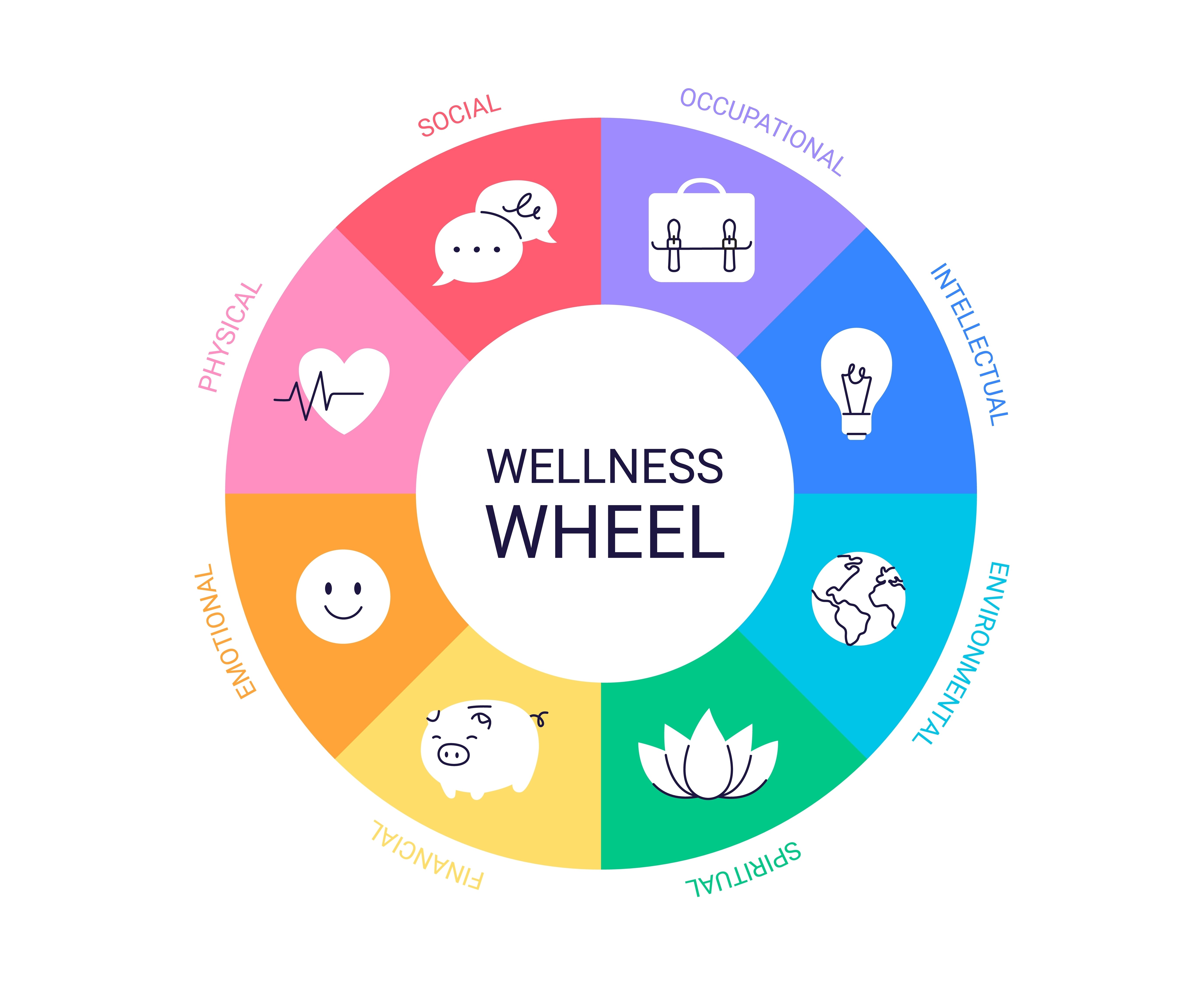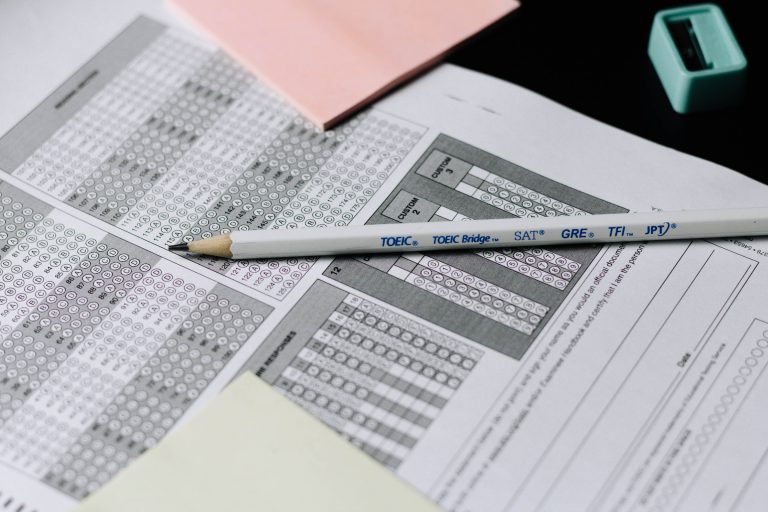The Wellness Wheel: Improving Well-Being and Academic Performance for Online Students
This is part 1 of a three-part series on online student health and wellness. This post will introduce health and wellness for students in an online setting. Part 2 will address mental and emotional health, and part 3 will address physical health.
Do I Have Time for Wellness?
As a student, you may have pulled an all-nighter fueled by caffeine every now and then to cram for an exam, or you might have attempted to survive on little but macaroni and cheese until your next paycheck came in. You probably felt tired and irritable or had trouble focusing. At other times, you have likely felt better when you got enough sleep and had a wider variety of food available to eat.
Likewise, maybe your day-to-day schedule has felt chaotic at times, while at others you have felt more at ease and better able to balance school, work, and relationships.

It can sometimes seem like students don’t have time to keep up habits like getting enough sleep, exercising, and eating balanced meals. However, these are the very things that support your overall well-being and help you function your best in every area of your life! You could say that you don’t have time not to invest in your wellness.
By creating a foundation of habits that promote health and wellness, students can increase their capacity for academic and career success. Day by day, you can improve your ability to study and learn effectively, make wise decisions about your education and career, develop lasting relationships, and maintain an active mind and body so that you are best able to make a positive impact on the world.
What Is Wellness?
When we talk about health and wellness, it’s helpful to understand what they are and what they are not.
Health is defined by the World Health Organization as “a state of complete physical, mental, and social well-being and not merely the absence of disease or infirmity” (WHO).
Health, therefore, is not a destination but rather a state of balance. It’s not about forcing your body to look a certain way or going to extremes to avoid sickness. It’s not just about avoiding negative health outcomes but about supporting positive well-being.
Wellness is defined by the Global Wellness Institute as “the active pursuit of activities, choices, and lifestyles that lead to a state of holistic health.” Wellness is the journey that we take as we improve and maintain balance in our lives.

Social media often paints wellness as an elaborate lifestyle full of fitness classes, expensive supplements, and perfectly timed morning routines. But the truth is that wellness doesn’t look one single way. Wellness can, of course, include habits like regular exercise—but for one person, that may look like running marathons, while for another, it may include simple rehabilitation exercises to heal an injury. While one person might benefit from mindfulness practices, another might be better able to process emotions through journaling.
Individuals can cultivate wellness in a variety of different ways that allow them to live a meaningful and purposeful life. Our physical and social environments—such as access to health care, clean air and water, and work and educational opportunities, as well as social norms and expectations—also significantly affect our wellness and quality of life.
The Wellness Wheel
Wellness is holistic. The wellness wheel below illustrates how wellness is composed of many interrelated areas that influence our overall well-being. While we may be better attuned to our wellness in one area or another throughout our lives, making positive strides in one area can shift our experience of wellness in all areas!

Below is a description of each part of the wellness wheel. As you read each one, think about what types of habits and practices could best help you improve your wellness in that area, given your current activities, responsibilities, and abilities.
- Physical—the ability to implement behaviors that promote a healthy body, such as exercising regularly, eating nutritious food, getting enough sleep, and preventing illness and injuries.
- Social—the ability to create and maintain a sense of connection and belonging with others through supportive relationships.
- Occupational—the ability to achieve a sense of personal satisfaction and success, and to maintain an appropriate balance between work and other pursuits.
- Intellectual—the ability to recognize creative abilities and to expand your knowledge and skills.
- Environmental—the ability to recognize interactions between yourself, your community, and your environment and to engage in environments that are safe, clean, and sustainable; along with the ability to make a positive impact on your home, community, and planet.
- Spiritual—the ability to recognize and pursue a sense of purpose and meaning in life and to develop values, morals, and ethics that guide your actions.
- Financial—the ability to manage your personal financial situation effectively and achieve financial goals.
- Emotional—the ability to effectively adapt to changes and challenges in life and experience a range of emotions in a constructive way.
Using the Wellness Wheel
Online students face specific challenges in balancing each part of their overall wellness. For example, you may need to pay more attention to your physical health as you are likely sitting at a desk for long periods of time. You might look around and see how you can improve your home environment to better support your well-being. You may need to seek out social connections more actively since you don’t see your peers in person. You may need to find outlets for emotional processing and regulation, such as finding time to go outside, pursuing creative endeavors, and taking regular breaks.
For more details, read this article from TalkSpace for tips on improving each aspect of the wellness wheel: Understanding the Wellness Wheel: 7 Dimensions of Wellness.
Your university likely has wellness resources available, such as counseling services, peer coaching, informational articles, and online resource and wellness centers.
How Does Wellness Affect Academic Achievement?
Now that we better understand health and wellness, let’s dive into the research on how they can affect students’ academic experience and achievement.
Studies on the effects of student well-being on academic performance are often inconclusive, given that there is no straightforward measure of well-being or of the various factors that affect both well-being and academic outcomes. However, Holzer et al. (2022) tie the two together by identifying correlations between academic achievement and optimism, engagement, and perseverance.
Similarly, greater consideration for well-being is correlated with higher school attendance, better self-control when completing school-related tasks, and higher perceived self-efficacy in managing academic challenges.
An impact study conducted by Dr. Ariel Lindorff at Oxford University (2020) analyzed research from a wide range of countries on student well-being and academic outcomes. This analysis showed convincing evidence of the link between well-being and academic attainment. Student well-being additionally promotes better long-term engagement in school and reduces dropout rates. Conversely, poor health is associated with a higher risk of dropout, and risky behaviors like drug use have a negative effect on academic performance.
Although the Oxford study focuses mainly on primary and secondary schools, these school years are crucial to students establishing health behaviors and learning skills to maintain their well-being throughout higher education and the rest of their lives. Lindorff emphasizes the importance of “whole-school approaches” to student well-being in improving not only academic outcomes but also mental health, self-esteem, self-efficacy, motivation, creativity, and behavior. In this approach, schooling goes beyond just helping students gain knowledge—it helps them become well-rounded adults who are prepared to make a positive difference in their families, communities, and society.
Well-being is multidimensional, and it cannot be fully captured in terms of academic achievement, grades, or graduation rates. It is important to note that, while increased school-related stress can drive performance and academic achievement, too much focus on grades and pressure to perform can negatively impact overall student well-being (Klapp, Klapp, & Gustafsson, 2024).

Wellness Is Balance
When it comes down to it, wellness is always a balance, and sometimes we need to emphasize one aspect of the wellness wheel over another in the course of our lives. All of us have faced decisions between staying up late to finish a project and getting enough sleep to sustain the next day’s activities, between spending time with family and friends or finishing up a work project, or between cooking a nutritious meal or getting takeout for the sake of time.
The takeaway? Students who establish a lifestyle that promotes overall wellness and are able to navigate trade-offs to achieve balance throughout their lives are more likely to achieve their academic and career goals.
References
Global Wellness Institute. (n.d.). What is wellness? https://globalwellnessinstitute.org/what-is-wellness/
Holzer, J., Bürger, S., Lüftenegger, M., & Schober, B. (2022). Revealing associations between students’ school-related well-being, achievement goals, and academic achievement. Learning and Individual Differences, 95. https://doi.org/10.1016/j.lindif.2022.102140
Klapp, T., Klapp, A., & Gustafsson, J. (2024). Relations between students’ well-being and academic achievement: evidence from Swedish compulsory school. European Journal of the Psychology of Education, 39, 275–296. https://link.springer.com/article/10.1007/s10212-023-00690-9
Lindorff, A. (2020). The impact of promoting student wellbeing on student academic and non-academic outcomes: An analysis of the evidence. Oxford Impact Study. https://oxfordimpact.oup.com/home/wellbeing-impact-study/
Sidi, T. (2022, March 25). Understanding the wellness wheel: 7 dimensions of wellness. Talkspace. https://www.talkspace.com/blog/wellness-wheel/
University of Illinois Urbana-Champaign. (n.d.). Understanding health vs. wellness vs. wellbeing. https://wellness.illinois.edu/about/health-vs-wellness-vs-wellbeing
World Health Organization. (n.d.). Health and well-being. https://www.who.int/data/gho/data/major-themes/health-and-well-being








